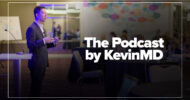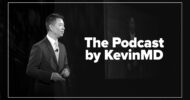Subscribe to The Podcast by KevinMD. Watch on YouTube. Catch up on old episodes!
Professional development practitioner and veteran emergency nurse Kristen Cline discusses her article, “America’s ER crisis: Why the system is collapsing from within.” Using the TV drama “The Pitt” as a reference point, she argues that the reality of the emergency department is exponentially more chaotic and dangerous than portrayed. Kristen shares her frontline perspective on the intersecting crises crippling the system: an epidemic of workplace violence where assault is treated as “part of the job,” a wisdom gap created by an exodus of experienced nurses, and a perpetual backlog caused by hospital overcrowding and a lack of downstream facilities. The conversation reveals how profit-driven management and impending Medicaid cuts are accelerating the closure of rural hospitals and vital services, creating health care deserts. Her core message is a stark warning: the safety net is tearing, and it has been held together only by the sacrifice of health care workers who are running out of hope.
Careers by KevinMD is your gateway to health care success. We connect you with real-time, exclusive resources like job boards, news updates, and salary insights, all tailored for health care professionals. With expertise in uniting top talent and leading employers across the nation’s largest health care hiring network, we’re your partner in shaping health care’s future. Fulfill your health care journey at KevinMD.com/careers.
VISIT SPONSOR → https://kevinmd.com/careers
Discovering disability insurance? Pattern understands your concerns. Over 20,000 doctors trust us for straightforward, affordable coverage. We handle everything from quotes to paperwork. Say goodbye to insurance stress – visit Pattern today at KevinMD.com/pattern.
VISIT SPONSOR → https://kevinmd.com/pattern
SUBSCRIBE TO THE PODCAST → https://www.kevinmd.com/podcast
RECOMMENDED BY KEVINMD → https://www.kevinmd.com/recommended
Transcript
Kevin Pho: Hi, and welcome to the show. Subscribe at KevinMD.com/podcast. Today we welcome Kristen Cline. She’s a professional development practitioner and emergency nurse. Today’s KevinMD article is “America’s ER crisis: Why the system is collapsing from within.” Kristen, welcome to the show.
Kristen Cline: Hi, Kevin. It’s so great to be here. Thank you for having me. And thank you for publishing my article. As you know, I started out the article talking about The Pitt, which is kind of having a cultural moment. Anytime that our health care and medicine, especially in a really lifelike way, is in the public forefront of the public’s mind, I think it’s really important that we capitalize on that.
For me, I’ve been an emergency nurse for almost 20 years. I’ve worked in emergency departments of all different sizes. I was a flight nurse for about six years, so I was in and out of facilities all over the country. I feel like I’ve had a really nice top-down view of hospitals and emergency departments over the past two decades. I liked The Pitt because it was realistic. It was almost too realistic in that, being in that world for so long, it was predictable. I could kind of see what was coming. I knew what was coming. I was impressed by the attention to detail they took to learn the procedures and learn the realistic way that emergency departments work so that they could depict them somewhat realistically to the lay people of the country.
As good of a job as it did, I didn’t think that it went far enough, actually. It felt very controlled. The chaos felt very slow-paced. I felt like I really wanted to express to people, especially with the big, beautiful bill passing, which has a lot of stuff in it that could potentially affect our life in health care, affect the way hospitals work, and affect our patients’ lives. I felt I had a unique perspective on what hospitals have been like over the last 20 to 25 years and what we look like now in a post-pandemic world.
I think what the public doesn’t understand post-pandemic is that it’s so much worse than it used to be. That was what I felt like The Pitt didn’t really depict: the true insanity of emergency departments now, how busy they are, how overcrowded they are, and how we’re taking care of patients right now in every space we can find. We’re cramming chairs in corners, we’re setting up hallway beds, we’re seeing people in the lobby, just trying to get through patients, just trying to see the patients that we can.
We get so backed up by the hospital processes. We have hospital overcrowding. Right now, hospitals are running at 85 percent capacity, which leaves us no surge capacity as a nation. We’ve been running at our surge capacity since the pandemic started. So we really don’t have a lot of wiggle room for our stressed health care system. You start with hospital overcrowding. We have rehab centers and post-acute care facilities closing due to losing their Medicare dollars, so there are fewer places to discharge to. A few years ago, I was a trauma program manager, so I was managing the patient’s experience from the traumatic event all through their rehabilitation journey. Some of our trauma patients would sit inpatient for two weeks, three weeks, just looking for a bed, looking for a place to go, looking for a way to rehab.
As we get backlogged from the post-acute facilities, the inpatient beds get filled. Half the patients in the ER now are inpatients waiting for an inpatient bed, so we’re not even really doing a lot of emergency care in the emergency department because we’re doing so much inpatient care. We’re taking care of patients who don’t have a bed yet. And the care that they’re getting is not the care that they should be getting. That’s no fault of the emergency department. The emergency department is built to take care of emergent conditions: acute injuries, acute illnesses.
From the opposite side of the health care system, we have the lack of primary care, the lack of availability of primary care. We have the lack of primary care outside regular working hours, and so that really leaves people with no place to go apart from the emergency department. So we’re really kind of squished. It feels like in a lot of ways the modern emergency department is balanced on this kind of knife-point edge of, “Are we going to make it or not?” Every day feels very precarious. For a lot of us frontline health care workers who have been holding the line for a really long time, it’s really tough out there. It’s tough in the ways it always has been, and it’s tough in a whole lot of new ways that we haven’t really trained for.
Kevin Pho: So you started, of course, mentioning the TV show The Pitt. For those who aren’t familiar, it’s an HBO show that has been highly acclaimed as being very realistic. But sometimes you’re saying that it’s not realistic enough. And a lot of the symptoms that you described just previously are leading to things like burnout and staff shortages, and it doesn’t seem like there’s a lot of light at the end of the tunnel. So what would you do to fix this? Is it simply just a matter of money? From your vantage point as an emergency nurse over the decades, how can we fix something like this?
Kristen Cline: I’ve kind of given up hope that a solution is going to come from somewhere else, from the top down. I think the thinking that’s happening at the top of health care right now, especially with all these MBAs who have entered health care administration, is that you have a lot of people making business decisions, not patient-centered decisions. I think change in the system is going to have to come from the ground up. Those of us who are the frontline health care workers, if we want to change it, we are really going to have to be the ones to lead that change.
For me, in a perfect world, so much of that starts with educational support. I feel very lucky; I’m in a system that has really solid, robust educational support. It’s an academic system and it’s one of the top ones in the country. I’m really lucky to be here. But it’s the only hospital I’ve been at in the past five years that has given any real consideration to continuing education for providers.
The providers that were trained during the pandemic had a really degraded training experience because they weren’t able to get into hospitals to do clinical rotations. For a nursing student, let’s say, you are supposed to have somewhere around 600 clinical hours by the time you graduate. You had nurses and our physician residents as well who for the past few years struggled to get in that clinical time, and so they’re graduating less prepared than they have been in the past. What that means for hospitals is that we have to take the responsibility to meet that training gap. We know that it’s there. If I know that my workforce is not prepared, then it’s my job to get them prepared so that they can operate at the level that they need to be at. Hospitals are not really doing that, and they’re not prepared to do it. Hospital leadership is thinking, “Well, it’s not our job to educate them. They went to school; that’s what they went to school for.” But with the speed that health care changes and the acuity of patients that we have—I think patients are much sicker now—hospitals have to take the lead in saying, “We’re going to support your transition. We’re going to give you the tools that you need to make this adequate transition.”
Because at least with nurses, what we’re seeing is that a new nurse, within three years, somewhere in the high 90 percent range of those nurses are looking to leave the bedside. They’re getting turned and burned. They’re there for a couple of years, and then they’re realizing, “This isn’t for me. This isn’t the way that I thought it was going to be.”
One of the ways that I talked about in the article, and this seems to be the part of my article that’s really resonated with our audiences, is the workplace violence aspect of it. The character in The Pitt that really resonated the most for me, obviously because she’s a nurse in a lot of ways, is Dana, the charge nurse. I felt like she was a very realistic character. And the most realistic part was when she got punched in the face, got a skull fracture, and still stayed at work. Had to work, couldn’t leave. I think lots of us in health care have gone to work sick, gone to work injured, and certainly, lots of us have gone to work, been assaulted at work, and then had to stay there.
That’s the next step of this equation: we really have to tackle the problem of workplace violence. Health care organizations have been lobbying for these protections for a really long time, but we haven’t made a whole lot of headway. I’ve been to D.C., I’ve been to my state houses, talking to senators and representatives, sharing one-on-one the stories of what has happened to me, the times that I’ve been assaulted. Those stories are really powerful if we can tell them. So we have to get the public to help us advocate for ourselves.
Health care organizations are really hesitant to spend money on things that would mitigate workplace violence, like security in the waiting room, security that’s posted down in the emergency department and visible, and metal detectors. All of these things that help make our practice environment safer, hospitals aren’t willing to invest in. I think we really need to challenge the health care industry to deal with this problem because there’s really no other sector where violence is tolerated or even expected. You can’t go to Walmart and assault the checkout clerk, and the clerk doesn’t have to finish bagging your groceries and then bring them out to your car. That person gets arrested, and you’re allowed to clock out and get taken care of. You get something for your pain. But in health care, we don’t even allow people to clock out and deal with their injuries if they’re assaulted by a patient. Sometimes, I’ve had scenarios where I’ve had to take care of the patient that assaulted me for multiple days. In an ICU, I’ve had to be stuck in a room with them for 12-hour shifts at a time after that patient has hurt me.
So, one, as health care workers, when incidents like those happen to us, we need to have really good boundaries and say, “No, I’m not OK. I need to get this taken care of, so I’m going to clock out, go to employee health to get checked over and get this documented as a workplace injury. I’m going to go see a physician and get this taken care of and do what I need to do to take care of myself.” Part of the reason that hospitals can make this a lower priority is that we make it a low priority for them. If we’re willing to work while we’re injured or hurt, then they don’t have to really do anything about it. And the system can kind of control itself because then, if you don’t see your peers going to get their injuries taken care of, if you don’t see your peers making a violence incident a big deal, or if you report it and nothing happens, you are much less likely to report incidents in the future.
Kevin Pho: So you mentioned that a lot of hospitals are not willing to spend on the resources for security for health care staff. What are some of the reasons for that?
Kristen Cline: It’s just very expensive. What I’ve been told by some lobbyists that I know in D.C. is that the hospital associations are lobbying against these protections for us. So when we’re going in there and saying we need these protections, the hospital associations are coming in behind us and saying, “Well, we really can’t afford to do it. Health care is already so expensive. It will be too expensive for us to make the changes that we need to staff to a point where if somebody gets hurt and needs to go home, they can.” We’re not staffing at the very edge of how we can safely take care of patients. It’s really an investment in better training. We get sent to CPI and some of these other de-escalation activities that don’t really do the trick. They teach us basic safety, how to tell if a patient is escalating, but we don’t teach people what to do if you do get injured, what the next steps are after that. We kind of leave that murky for a good reason.
I think the second part of that is we have to figure out how to have law enforcement help us with this. I’ve been told by law enforcement that this is what I signed up for, that it’s part of my job to get assaulted. “Wow.” And, “I’m not going to take the report because the person won’t even show up, so it doesn’t matter.” What the outside system tells us is that we don’t matter. What happens to us doesn’t matter.
That, to me, is a huge leak of staff because if I come to work and I feel like I don’t matter, I feel like I’m just another body—which administration looks at nursing that way, a nurse is a nurse is a nurse—they’re not valuing longevity. They’re not valuing the wisdom that comes from staying at the bedside. They just see it as, “We’ll just fill that up again.” But they don’t realize the skill, the wisdom, the knowledge that you’re losing when we have so much turnover. That means there are fewer Danas out there. There are fewer Danas who can handle everything because the younger generation is looking at the landscape and being like, “This is crazy. I can’t stay here.”
For people’s own safety, for their own mental health, you have to take care of yourself. But hospitals are going to have to take it seriously. They’re going to have to take staffing seriously. They’re going to have to take safety seriously, which costs money. It does upfront, but I think the benefit is that we will have a steady health care workforce that is able to take care of our aging population. As our population gets older, there’s something like 40,000 people aging into Medicare every day. So the need for health care clinicians is only going to go up. But if we have this leaky sieve of the way hospitals work, we can’t get on top of these systemic errors because we’re just kind of spinning our wheels with the basics the whole time.
Kevin Pho: We’re talking to Kristen Cline, emergency nurse and professional development practitioner. Today’s KevinMD article is “America’s ER crisis: Why the system is collapsing from within.” So, Kristen, despite all these dark clouds that are really haunting our emergency system, maybe we could end on a positive note. Why do you keep doing what you’re doing, and what are some words of inspiration you could share with other frontline clinicians in terms of why they should pursue patient care in the emergency department setting?
Kristen Cline: That’s a great question. And I will say there’s really a lot that keeps me going back. Part of what I do in my work now as a staff development practitioner, I’m an educator for the nurses in the emergency department, so I’m taking all my experience and infusing it into the new nurses that I get to work with. Something that’s really uplifting for me is seeing the nurses and the physician residents that are coming into the hospitals. They still have hope. People are still going into this for the right reasons. It surprises me that people are still coming out of nursing school really excited to do it and really excited to take care of people. I’m hopeful that Gen Z and Gen Alpha, these generations coming after us, are still excited about helping people. They’re a caring and more empathetic generation. It’s really nice to get to work with talented, really passionate health care workers.
The other kind of bright spot for me is the patient interactions. You still have an opportunity every time you interact with somebody to make a human connection with them. It’s challenging because people are more frustrated now. People are meaner sometimes. People are more difficult to deal with. I think it’s even more important now for our practice that we look for those ways that we can just take care of each other. Little ways we can take care of our patients just to try to make a human connection with them. That’s what keeps you in health care, I feel like: connecting with the people around you, supporting your fellow coworkers, and helping people where you can to make their day better.
I think if we can learn good boundaries as a profession, if we learn to leave work at work when we clock out, if we can leave work at work and go home and then have a rich home life where we’re taking care of ourselves and doing things that we enjoy, then when we’re coming to work, we’re present. We’re able to be there and be the best version of ourselves. If you have a bad day, you can start over next time. We always have opportunities to get better.
I do feel like the changes that are coming in health care are positive. They’re going to hurt, I think, because we know we can’t go on this way for too much longer. But I do think once we kind of break the system, what we build from that will be so much better. I think the things that the pandemic broke needed to break. They weren’t working anyway. Something positive that I see about everything kind of falling apart around us is that it gives us an opportunity to build it up the way we want it to be.
That’s kind of why I wanted to write the article: to rally people to say that we don’t like the way it is right now. But we are health care; it’s made of us. So if we don’t like the way it is right now, we have the power to change it. We just have to be engaged and be willing to do it and be dedicated to our patients, to our profession, and to our colleagues. So I still go to work every day being very energized by the chances that I get to make a difference. I think there are lots of clinicians out there that feel the same way. And so if we’re all out there giving our best, I think there is hope for us.
Kevin Pho: Kristen, thank you so much for sharing your story and insight. Thanks again for coming on the show.
Kristen Cline: Thank you for having me.
























